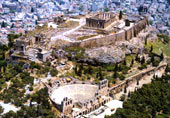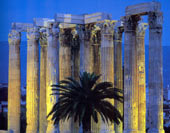The Theatre of Dionysus
No trace has been preserved of the 5th-century theatre, which must have been simple in form with a few rows of wooden and stone seats. The theatre of Dionysus must have been situated on the south slope of Acropolis.
Keramikos
Kerameikos was named after the community of the potters (kerameis in greek) who occupied the whole area along the banks of the river Heridanos. The walls of Athens, which were constructed in the 5th century BC by Themistocles, divided the area into two sections, the "inner" and the "outer" Kerameikos. Part of this wall and its gates is still preserved. Here you will also see:
- The Pompeion. A specious building with peristyle courtyard, used for the preparation of festival processions. In the Pompeion were kept the sacral items used at the Panathecic procession.
- The Sacred Gate was one of the gates of the city wall built by Themistocles in 478 BC. It allowed the passage of river Heridanos and the Sacred Way, the processional way that led to Eleusis.
- The "Demosion Sema" was the public cemetery of the city,extended just outside the Dipylon gate. The finds from excavations of Kerameikos are exhibited in the Museum of Kerameikos and the National Archeological Museum. The site is open daily 8am-7.30pm and is located in 148 Ermou Str.

The Odeon of Herodes Atticus
It is the third Odeion to be built in Athens, after the Odeion of Perikles and that of Agrippa. It was erected by Herodes in the memory of his wife Regilla, who died in 160 AD. It is shaped as a semicircular theatre and has excellent acoustic capacity. During the summer it houses the Athenian Festival. You should not miss going to on of the performances.
Phillopappous Monument
Dated to 114-116 AD, the Philopappos monument was erected by the Athenians in honor of the great benefactor of their city, the exiled prince of Commagene, Julius Antiochus Philopappos who settled in Athens, became a citizen and assumed civic and religious offices. The monument measures 9.80X9.30 m and contains the burial chamber. The three inscriptions below the statues record the names of the persons represented. The central figure is Philopappos, son of Epiphanes, on the left is Antiochus, son of king Antiochus, and on the right was king Seleucus Nicator, son of Antiochus. The results of recent investigations have certified that architectural parts of the superstructure of the monument had been used for the construction of the Minaret in the Parthenon.

A very interesting stroll
Starting from Pyli Adrianou (Hadrian's Arch) on Amalias Avenue, enter the "Stiles Olympiou Dios" (Olympeion). Then come back to the entrance, cross the street and take the pedestrian street of Dionyssiou Aeropagitou all the way up to Acropolis. Marvel from above the Odeum of Herodus Atticus. Enter the Propylaia and walk around the Parthenon, the Erechteion, the Temple of Athena Nike.
End your visit at the Acropolis with the Acropolis Museum. Climb down to a small rock with a excellent view on Athens., Areios Pagos, where Socrates was trailed. From there walk towards Plaka. The first gate you enter (on your left) leads you straight to the Ancient Agora from the back. It should take some time to see where democracy and philosophy were born.
If after all that, you have some time left, visit the Kerameikos om 148 Ermou Street or the Horologion of Andronicos (Tower of the Winds) and the Roman Agora in Plaka.
